2013 Ironman Florida Race Report
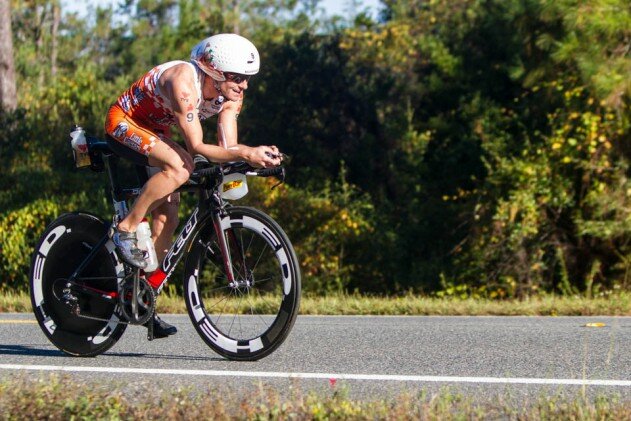
Photo by Triathlete Magazine.com
I must say, that it is much easier to write a race report when I have a good race than when it’s the other way around. I usually try to get a race report posted within a week of a race, but when the day doesn’t meet my expectations, I find myself procrastinating. It’s not difficult to understand why, we love to announce our successes in life and sweep our failures under the rug. Just read your Facebook feed and you’ll find plenty of posts about peoples’ positives in life, but a lack of gloating about significant failures. Sure, folks will announce the mundane and insignificant life failures like burning toast or sleeping past their alarm clocks, but rarely will they reveal a true life letdown.
In my career, as well as any other job where public awareness is a portion of your value, we must show our rough times as well as the good. This fact doesn’t take the sting off of the ego, but I’m finding that I’m better learning (albeit slowly) how to cope with the results that don’t meet my expectations. The first letdown happens in the moment of event and directly following. After a couple days, I’ve usually dealt with my feelings and have moved on. Then I have to update my website with a race report and report in with my sponsors. It’s like pulling the scab off again, or rather standing in your underwear on stage in front of an audience as I post to the world about what I see as my failures.
At Ironman Florida last weekend, I ended the race with 18 miles of walk/jogging. At mile 8, I laid down in the grass at the side of the road for about 10 minutes contemplating dropping out. Eventually, I pulled myself together, got up, and walk/jogged my way through the majority of the marathon. I’m glad I finished the race. Going into the off-season with another DNF on my 2013 resume would have stung much worse. In the 9 days since the race, I think I’ve gone through all phases of coping. First, I felt relieved to be done. I felt a “glad that’s over-with, let’s just be done with this year.” After about 36 hours, I got really down about the race, then 24 hours later, I felt very angry. Then after several days, I came to a healthy level of acceptance.
If every race had gone average-good this season, one bad race would have been no problem. Traditionally, I have one to two bad races each year. If I’m racing 7 Ironman or Ironman 70.3 races, then 5-6 good races and 1-2 bad seems to be a decent average. This year I had two good races and the rest were terrible. I was 2-for-7 this year. Now granted, those two were each second place finishes at full Ironmans (Australia and Louisville). If I look back at the last 2.5 years, I have one Ironman win and 4x 2nd place finishes. When I framing it that way, I’m very happy. But, if I look at this season in a vacuum, I’m having a difficult time focusing on those two positive races. I had four of my absolute worst 70.3s and one bad Ironman after Louisville and Australia. Believe me, I’m trying to focus on the good, and to be honest at this moment I think I’m actually at a healthy point of objectivity looking at this year. I’m recognizing the successes, but also am being realistic about the other five races. The recovering-engineer in me is dissecting the my year from a physiological and psychological standpoint. Even though I’m only 9 days into my “off-season” I’m already on the road to making changes for next year to correct the racing inconsistency I’ve experienced over the last 18 months. I will write an entire blog dedicated in the near future to discuss the changes I‘m making for next season. I’m as excited as ever for next year. I feel that I’m making the right decisions now to put myself in position for a great year of racing in 2014. More to come on that….
Back to Ironman Florida:
Coming into Ironman Florida I had more confidence in my fitness than I’d had all season. I’d been swimming and biking better in training than I had all season. I’d pulled the power meter back out for the first time since March and had put in some solid sessions that told me I was fit and strong. I hadn’t done a ton of running speed work, but I was focused on a lot of longer race-level efforts. I felt confident that I’d be able to hold a strong pace in the marathon.
Ironman Florida is a unique race on the Ironman circuit. First, it always gets one of the largest professional fields in the sport. I never looked to see how many male professionals actually started, but the original start list had 78 male professionals. That doesn’t change my fitness or confidence going into the race, rather it just means that there are some different tactical decisions during the race. The second unique factor about Florida is the very flat and fast bike course. It’s one that gives a larger advantage to guys riding in a group than riding as individuals. Someone who is a faster swimmer and maybe not as strong on the bike can have a big advantage if they can situate themselves in a large pace line of bikes. I’m not complaining, that’s just the way the race plays out. There’s a screen play for Ironman Florida and that’s the majority of it.
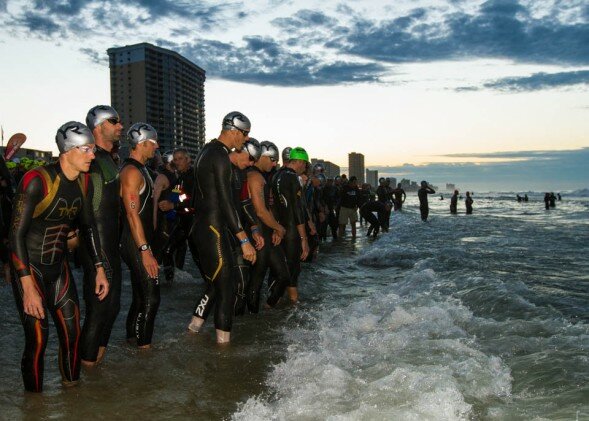
The professional men line up seconds before the start gun. Yours truly is front and center in my TYR Freak of Nature wetsuit. Photo by Triathlete Magazine.com
Race morning, we had a little choppy water with some good size short breaks. When the start gun blew, the swim seemed to be broken up immediately through the breakers. There’s also a lot of space on this swim, so it didn’t feel like a rough swim from the melee standpoint. I felt like I’d had a decent swim, but breaking down the times afterwards, once again, I didn’t swim anywhere near my potential. I didn’t swim up to how I’ve been swimming in the pool. I finished with a swim of 56 minutes, where if I’d swum where I think my ability level is now, I should have been in the 52-53 minute range. This has been a constant battle and theme for me. At some other races, coming out a little further behind on the swim doesn’t hurt me as much. At Florida, it’s a game changer. I kept telling myself that it’s a long day and many of the guys ahead would overbike and suffer on the run.
In about 5-6 miles I caught a group of a half-dozen or more guys. Without a draft marshal on the spot, there were a lot of liberties being taken by the guys in terms of riding legal distances. After a couple minutes at the back right after I caught the group, I moved to the front to set the pace. One other guy, Adam Bohach was willing to come to the front and switch off with me at the lead to set the pace. He and I worked the front of the group while the rest of the guys sat in back sucking off of us like leeches. I’ve learned to try not to let that bother me. I don’t think to myself that I’m racing those guys behind in the group, rather we are racing a huge group of guys several minutes up the road. I just hate the speedup/slowdown of riding with a group. I’d rather ride my own pace and be steady rather than surging and slowing to stay out of drafting zones.
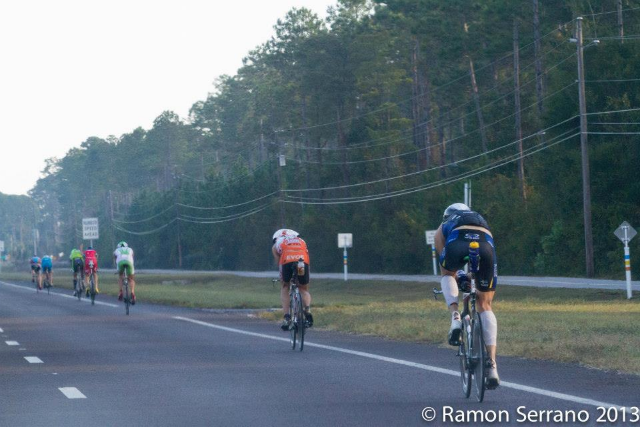
After catching the first group of guys. Hmm, looks like my spacing is the most legal. You can make your own judgments. The rule is 10 meters or 33 ft, which is about a 3 story building. "Mr. Red" up there in isn't even trying to make it look like he's riding legal. Photo by Ramon Serrano
Somewhere around mile 30 I saw Brooke Daerr (Justin Daerr’s wife). She yelled to me that I was about 2:30 behind the main group. I decided to push the throttle a little harder to see if I had a chance to catch the lead group. I knew that any chance at a top-10 finish was up the road in the main pack, not sitting back playing reindeer games with this smaller group. I pushed for a good 15-30 minutes. This is where I saw Brooke again who’d driven up the road. She told me that the group was now about 2 minutes ahead. That was good, I’d made up 30 seconds in a short period of time. I kept the same pace hoping to continue to bring the gap down. On the out-and-back section, I could see the front groups had come together into one huge group of 27 guys. As Justin told me after, he said he felt bad for me seeing me bike alone, chasing a massive group of 27 guys. We both knew the top-3, top-5, and top-10 were all going to come out of that massive pace line of 27 guys. If I wasn’t in the group, it was going to be all up-hill. I felt really good from miles 30-65. I was still trying to bring in the group. After mile 65, I didn’t feel quite as spry, but I didn’t feel bad. After about mile 85 or 90, I felt terrible. I was hemorrhaging time to the lead group. I couldn’t keep the pace up. I was dying a slow death on the end of the bike. There was one more out-and-back on the course around mile 95. I saw the group there again and saw that I wasn’t gaining time, rather I was now losing big chunks of time. After the race, I was able to look at the splits and I went from gaining time to having lost about 6 minutes to the main group in the last 25 miles or so.
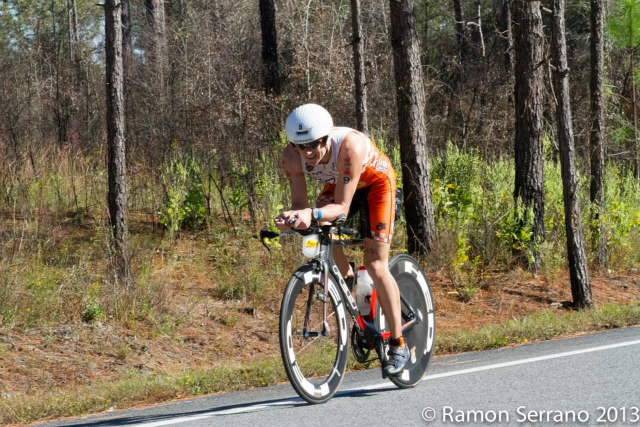
On my solo ride. Photo by Ramon Serrano
I had my fastest bike spilt, riding 4:26 almost entirely solo. I’m happy about that time, but it came at a cost. Riding alone, that kind of bike took a lot out of me. Also, when the lead group of 27 guys working together can bike 4:17-4:20, it’s a tall order to make up. That means they’re averaging well over 26 mph over 112 miles as a group. To close a gap, that means I would have to ride much faster.
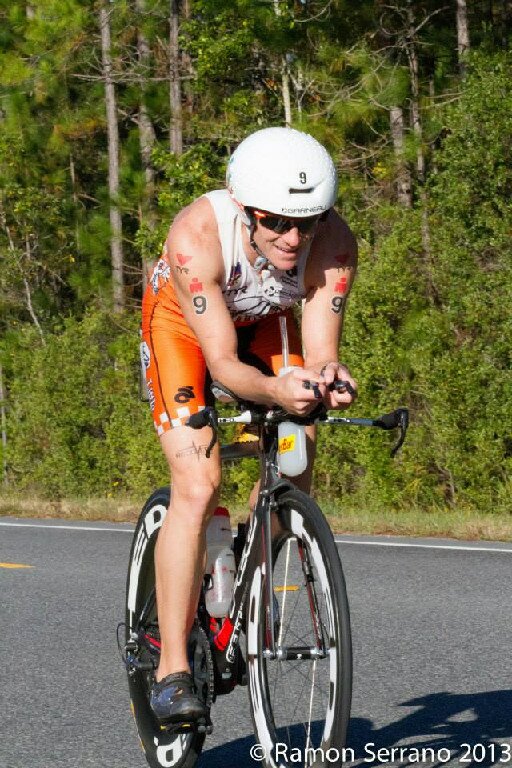
Photo by Ramon Serrano
Coming into transition, even though I was pretty tired after the bike and knowing I had an uphill battle to the top-10, my confidence was still high. I knew that several guys in the lead group had probably over-biked and would pay the price on the run (and so would I). I came out of transition and to be honest, my first mile of the run was great. I felt strong and like I may have the run of my career. Right around a mile and a half in, my entire lower body started to lock up. My glutes, hamstrings, and hips all were so tight, every stride I thought I may pull something. I slowed down and shortened my stride. Every time I’ve had a tightness early in an Ironman run, I can usually get it to loosen up after a few miles of slowing down and managing it. I was still clocking my miles. I wasn’t running super slow, I was still running 6:38-6:45 miles which is still in the 2:55 marathon range. I thought I may be able to get through it and pull out a good marathon. The problem was that even though I wasn’t running slow, I was getting passed left and right by guys running much faster. I knew it was bad when seeing my family, they didn’t give me any times, splits, or placements. They just said “good job, just do your own race.” I already knew it was bad. I got to the turn-around at the far end of loop one at about mile 6.5 and simply fell apart. I felt the fatigue, nothing was loosening up, and I just slowed way down. I did my shuffle run to my family and stopped. They were at mile 8. I just laid down in the grass. I couldn’t even think about another 18 miles of shuffling and walking. I wanted to be done with the race and done with the year. My body just felt beat up. I felt like I’d been beaten with a baseball bat from the waist down. I just wanted to lay on that grass for a week.
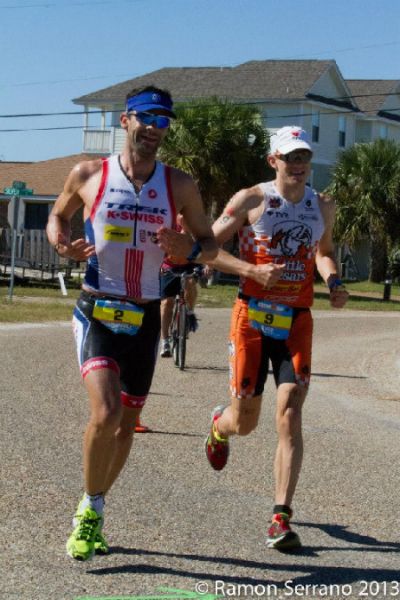 I don’t know exactly how long I lay there, maybe 10 minutes. I convinced myself that I’d be mad all winter if I quit another race to finish off my year. I knew Tim O’Donnell was about 10 minutes back, he had been battling being sick and wanted to just finish the race for his 2014 Kona validation. I decided to wait for Tim and thought I could have a jogging partner for 18 miles that I really had no desire to run. Tim came buy and I jumped back in the race. After a few hundred yards, I told Tim that this pace felt harder than I could hold. We still ran together for about a mile, but he was moving faster than I was able. Tim didn’t want to be out there all day, so he was running just to get done quicker (See Left, Tim and I running together, photo by Ramon Serrano).. After a mile or so, I stopped and walked. I decided to run a couple miles, then walk 5 minutes. I did that from mile 10 until about mile 14 or 15. At that point I knew my friend Dede Griesbauer was coming from behind. She’d started the run in the top-3 of the womens pro race and was fighting in the top-5 at that point. I thought I would be able to run with her and give her some moral support as long as I could. Dede and I ran together for a few miles. Eventually, my legs started locking up, so I told her good luck and started walking. I thought I’d walk for five minutes again, but at that point I couldn’t start running again. My five minute walk turned into 2.5 miles. I found a Belgian pro guy walking, so I made a new friend. We walked and chatted until I got to the final turn-around at mile 20. At that point I convinced myself to run again. I’d seen Merinda Carfrae behind me on the run, in fact she told me she’d catch me. Around mile 21 or 22 decided to walk again. I told myself that when Rinny caught me, I’d run with her. When she caught me, we decided to run together, run a mile, then walk 5 minutes, then run the last two miles in. We ran together, neither of us in a hurry at that point.
I don’t know exactly how long I lay there, maybe 10 minutes. I convinced myself that I’d be mad all winter if I quit another race to finish off my year. I knew Tim O’Donnell was about 10 minutes back, he had been battling being sick and wanted to just finish the race for his 2014 Kona validation. I decided to wait for Tim and thought I could have a jogging partner for 18 miles that I really had no desire to run. Tim came buy and I jumped back in the race. After a few hundred yards, I told Tim that this pace felt harder than I could hold. We still ran together for about a mile, but he was moving faster than I was able. Tim didn’t want to be out there all day, so he was running just to get done quicker (See Left, Tim and I running together, photo by Ramon Serrano).. After a mile or so, I stopped and walked. I decided to run a couple miles, then walk 5 minutes. I did that from mile 10 until about mile 14 or 15. At that point I knew my friend Dede Griesbauer was coming from behind. She’d started the run in the top-3 of the womens pro race and was fighting in the top-5 at that point. I thought I would be able to run with her and give her some moral support as long as I could. Dede and I ran together for a few miles. Eventually, my legs started locking up, so I told her good luck and started walking. I thought I’d walk for five minutes again, but at that point I couldn’t start running again. My five minute walk turned into 2.5 miles. I found a Belgian pro guy walking, so I made a new friend. We walked and chatted until I got to the final turn-around at mile 20. At that point I convinced myself to run again. I’d seen Merinda Carfrae behind me on the run, in fact she told me she’d catch me. Around mile 21 or 22 decided to walk again. I told myself that when Rinny caught me, I’d run with her. When she caught me, we decided to run together, run a mile, then walk 5 minutes, then run the last two miles in. We ran together, neither of us in a hurry at that point.We finished together, and I was happy to be done. I was glad I finished the race rather than laying on the grass at mile 8 until Wednesday like I’d wanted. I was just ready to close this chapter on 2013. I did enjoy the trip to Florida with my family. As I told them, I had a great time there with the exception of about 10 hours of my trip.
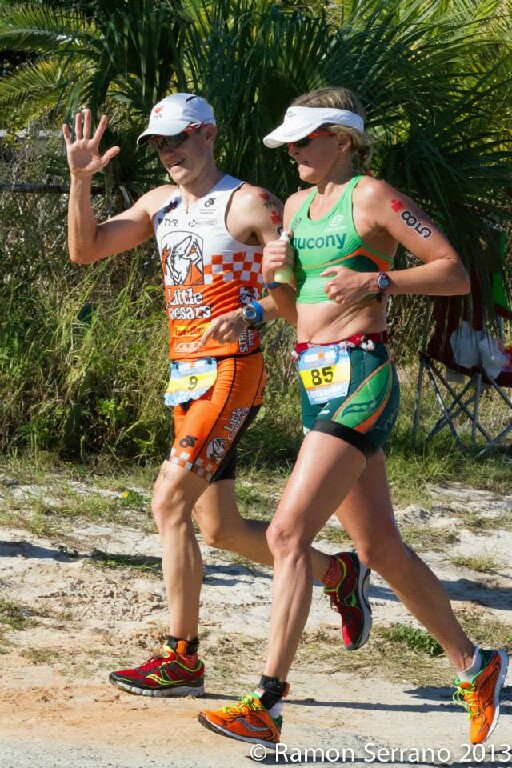
Dede and I running together, At least I could muster a smile! Photo by Ramon Serrano
With my season officially done, I’m taking 2 weeks completely off, at a minimum. I’m not even thinking about an easy bike or jog for two weeks. Then I’ll see how I feel after that. I need time to unwind and decompress after this year. I also need time for all of the little aches and pains to heal up. I am still excited for next year, but I have some work to do to make sure I get myself back on track for 2014, to get back to the consistent me, and grow as an athlete and person. But first, I have some rest, recovery, and decompression to attend to!
I want to thank Little Caesars Pizza for their support of me and my racing. Their belief in me is so important for me be able to do what I'm doing in this sport. TYR Sports is providing me with the best wetsuits and speedsuits in the sport. PowerBar's nutrition products have been a key part in my training and racing. I'd also like to thank RecoveryPump for their support. RecoveryPump has been a critical aspect of my training and recovery and I truely believe the product has helped to take my training to the next level. Jack and Adam's Bicycles in Austin are always there to help support me and my racing. I want to thank Felt Bicycles for putting me on such an amazing bike, the Felt DA. HED Cycling has provided me with the best wheels and aerobars on the market. Champion System Clothing has provided me with the race and training clothing that you see in my pictures. Brooks Airbrush Studio painted up my amazing aerohelmet this year. Atomic High Performance has coated my bicycle drive train with high performance low-friction coatings. Hill Country Running Company is a great help with my running equipment. SBR Sports Inc's products are also a great help for racing and training. Coach Brackin at Brackin Elite Swim Training has helped bring my swimming up to the next level. Also I want to thank my family and friends for their unending support for me. Without these people and sponsors, I would not be able to pursue this dream.
